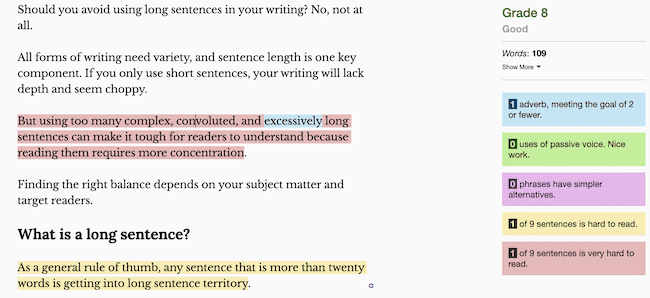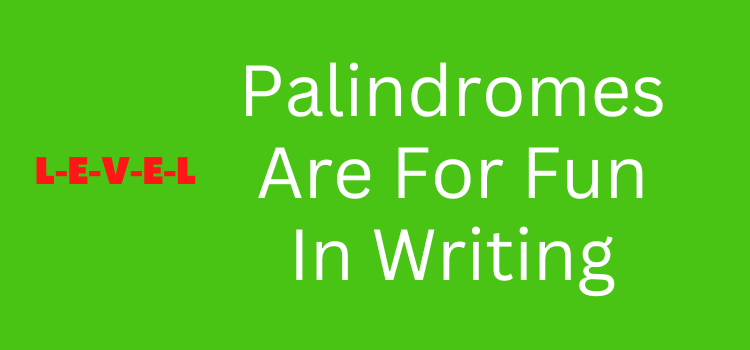
Should you avoid using long sentences in your writing? No, not at all.
All forms of writing need variety, and sentence length is one key component. If you only use short sentences, your writing will lack depth and seem choppy.
But using too many complex, convoluted, and excessively long sentences can make it tough for readers to understand because they require more concentration.
Finding the right balance depends on your subject matter and target readers.
What are long sentences?
As a general rule of thumb, any sentence that is more than twenty words is getting into long sentence territory.
Sentences that are longer than this become more difficult to read as the word count increases, making it challenging for your readers.
Siteimprove, which specializes in readability, gives the following reference scale.
Fairly difficult (Medium long sentence length): 21-25 words.
Difficult (Long sentence length): 25-30 words.
Very Difficult (Very long sentence length): 30-40 words.
Extremely difficult (Extremely long sentence length): 40+ words.
Another quick way to measure sentence reading difficulty is the Hemingway app.

It rates sentences of around 20 words in yellow as hard to read and, above that, in red as very hard to read.
When to use long, complex sentences
If you are writing academic or scientific texts, using long sentence structures is still very common.
Although there has been some change to more simplified writing, it seems that old habits die hard.
But both forms usually write about complex ideas and are not easy to articulate fully in short sentences.
Another classic use is in legal texts.
For example, terms and conditions on Internet sites and services often use an extraordinary number of words in a single sentence.
If you have bothered to read any of these documents, you know that they are almost impossible to understand.
That’s probably the whole purpose.
One sentence I found while researching this article was 232 words. I didn’t understand a word of it.
Vary your sentence length
If every sentence you write is between five and seven words, it will make for boring reading.
But using sentences of twenty words or more consistently makes a text difficult for people to read and comprehend.
All good writing uses variety, and it’s certainly true for sentence length.
By varying your sentences in a text, you will make it more interesting, engaging, and informative.
Here are some tips to help you.
Chop up the long ones
A long, complex sentence is always a set of simple sentences and clauses glued together.
Because of this, it’s easy to break them into smaller chunks that are much easier to understand.
Here’s an example of an overly complex sentence that is not easy to read.
As soon as I could try Google Gemini, I asked it to tell me which of these four words, blue, green, red, and yellow, was the odd one out, and it replied that yellow was the odd word because it was not a primary color, but the other three were primary colors proving to me that Gemin is not very intelligent AI, because an eight-year-old would know that green was the correct answer.
Here’s the fix, and now it’s much easier to read.
I tried Google Gemini by asking this question.
What’s the odd word out in the following four words: blue, red, green, and yellow?
Gemin replied that yellow was the odd word because it was not a primary color.
It proved to me that it is not very intelligent AI because an eight-year-old would know the correct answer is green.
You can see that rewriting the sentence, without resorting to overly short simple sentences, is much easier to understand.
As an aside, this is a true story about my experience with Google Gemini. Here’s the proof.

Join short sentences together
You have certainly read the advice that it’s always best to use short sentences to convey your message concisely.
But following this advice to the letter can make your writing too simplistic and lacking in depth, especially for forms of creative or informational writing.
Check your text for short sentences.
Are they close together?
You can join some of them.
All you need to do is add a comma or a conjunction word.
You could use and, but, or when.
Then you can create better sentences.
You could edit the example above in many ways to improve it. Here’s one way.
When you check a text, you often find short sentences close together.
Joining two with a comma or conjunction word like and, but, or when can usually create a better sentence.
Change your sentence structures
Good writing is not only about using short or long sentences.
Sentence types, such as declarative, interrogative, imperative, or exclamatory, express different ideas.
You can also vary tone, style, or syntax to add more variety.
If you always use a simple sentence structure, it can become repetitive.
I like reading and writing.
But you can change it into a compound sentence easily.
I like reading and writing because they stimulate my mind.
Using a conditional form is a good example of a complex sentence.
If you wanted to write a book, what would you write about?
The compound-complex sentence usually has two (or more) independent clauses and at least one dependent clause.
When I arrived here, I immediately enrolled in a language course because I wanted to be able to communicate effectively.
The big benefit of using or combining different sentence structures is that your sentence length will vary throughout your text.
Summary
Are long sentences a bad idea in writing?
It depends on who your readers are. If you are writing online, you want to accommodate as many readers as possible.
From the perspective of comprehension and ease of reading, using shorter sentences is better.
But it can come at the price of reducing the reading level so low that it fails to keep a reader’s interest.
Perhaps like Goldilocks, it’s a matter of deciding on what’s too short, too long, or just right for your style of writing.
The answer will be different for every writer.
But for me, I always try to write sentences that are as short as possible but as long as necessary.
Related Reading: How To Write Well – 10 Writing Tips For A New Writer
Share This Article


